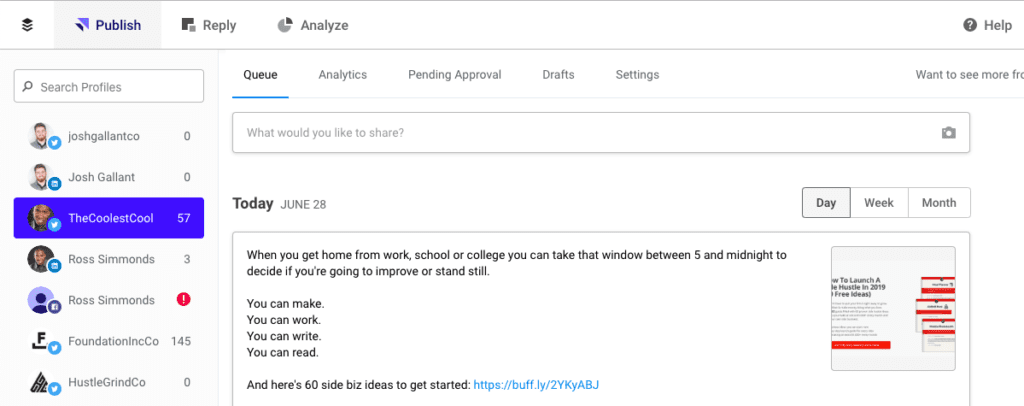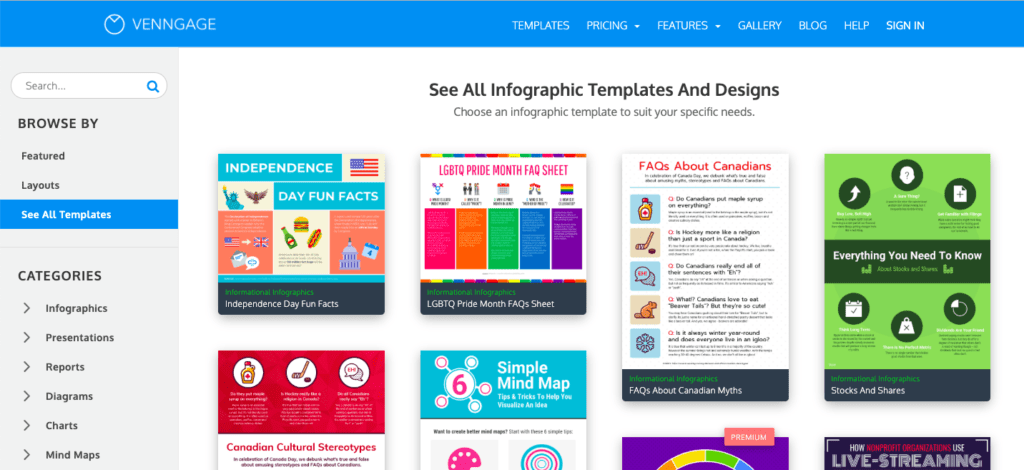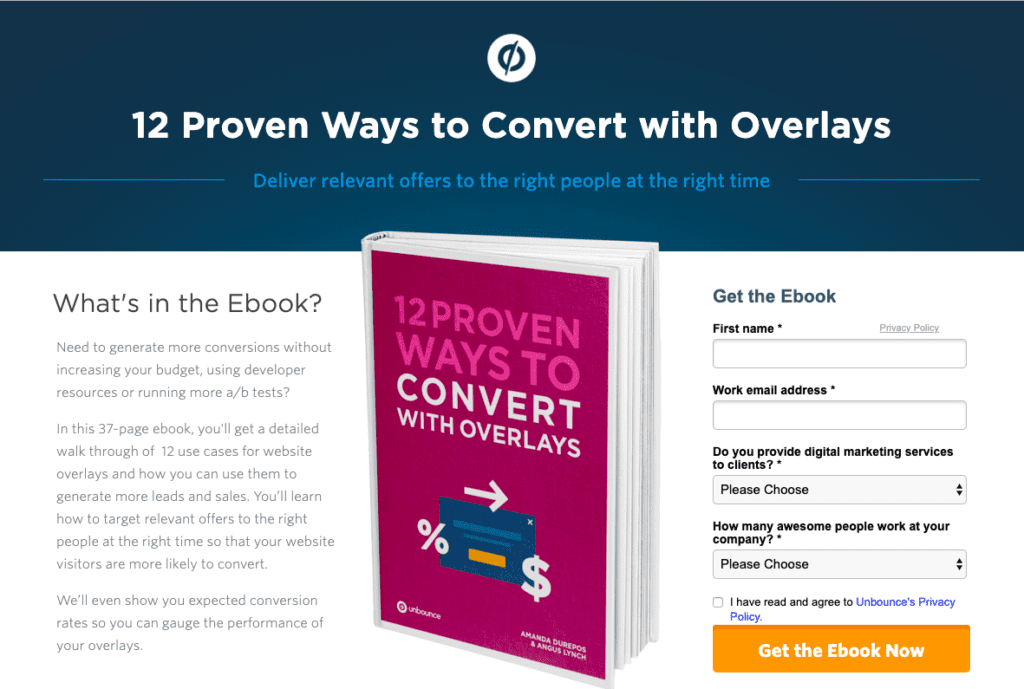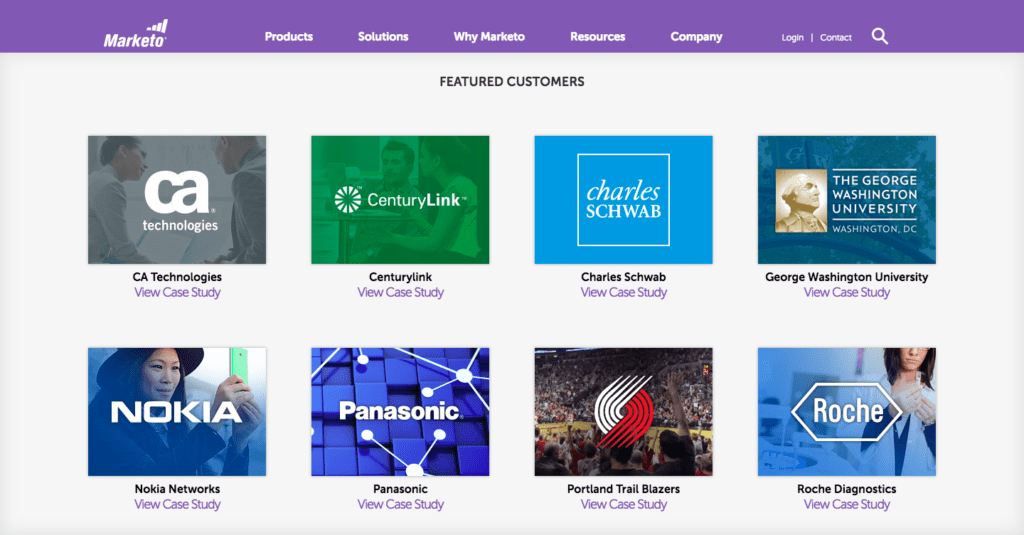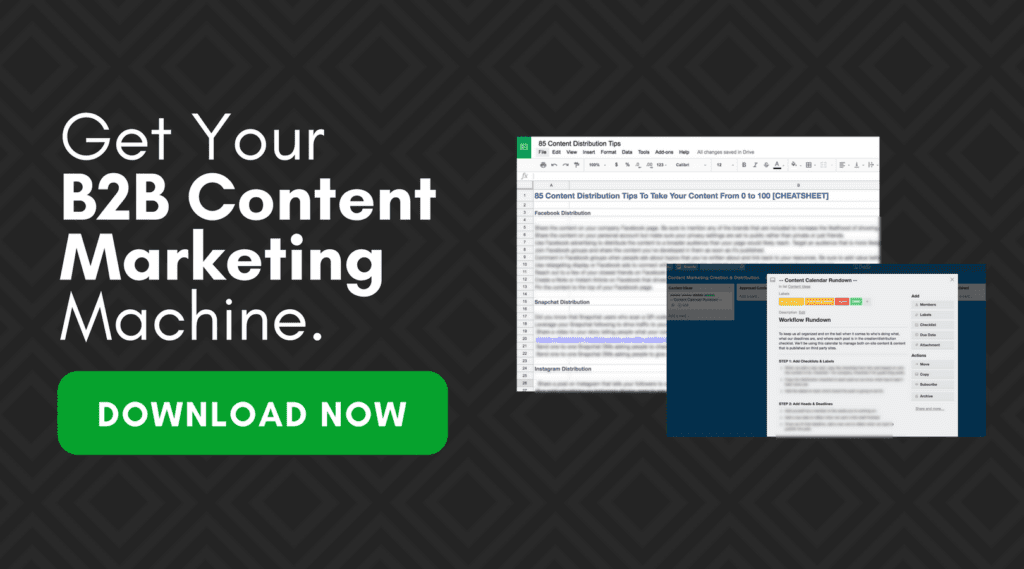You’ve heard the saying, “Content Is King”.
You recognize how essential having a content marketing strategy can be for your B2B or Enterprise startup, yet you haven’t implemented one…
Why not?
If you follow me, you know I actually preach that distribution is king. And while I still claim that to be true, there is nothing to distribute if you don’t create the content.
If you are like most B2B startups, you probably have a few hesitations as it relates to the concept of marketing and might even be afraid of marketing as a whole.
Fear not.
Content marketing can actually be a startup’s best friend. Especially in B2B!
What you need to recognize, first and foremost, is that companies search for things just like consumers do. When they need an answer or a solution, they often head to Google first to find it.
Often times, the first instinct of startups looking for early customer acquisition is to try and lure visitors to their site using Google Adwords or Facebook ads. I’ve done experiments with both paid and content-driven traffic and have found that, when done correctly, content driven traffic consistently performs better.
Content marketing is not something you can ignore. It is now a required element for any successful business. At the end of the day, content marketing is but one component of your overall marketing strategy, but it is one that can drive meaningful and measurable results for your business.
In the enterprise, there are a handful of questions as it relates to content marketing and social media as a whole.
Many startups are unsure how content marketing can play a role in generating leads for their sales teams. In reality, generating revenue from your content marketing efforts should be the goal at all times.
There is no room for fluff in your efforts; any content you create and distribute should be purposeful, and it should be directly tied to your B2B sales funnel and your target audience’s path to purchase.
You need to constantly be thinking about who will want this content and if this content will help them in a way that could lead to a conversion with your product.
Here I’m going to walk you through a few pieces of content you can create that have been proven to work for enterprise organizations looking to attract and convert clients:
Create Engaging and Captivating Blog Posts
Nothing beats a good ol’ fashioned blog post.
If you do nothing else, create a blog.
It’s one of the most basic, yet effective, ways to share your story and build your brand. I have friends and family members starting blogs and an inbox continually filled with people asking whether or not they should start one.
I tell everyone the same thing: If you care about reaching customers, developing an audience, communicating your mission, sharing a vision statement with your team, building your brand, marketing your product, or building relationships with others in the industry, a blog is a great way to find success.
The whole point of content marketing is to be able to contribute to the conversation, add value and drive demand for your product or service. Contributing regular and consistent value is how you get your name and business recognized as an authority figure in the industry.
As you create content on your blog, you’re essentially building yourself as an expert in a specific field and elevating your brand with every post.
Keep in mind as you’re creating your blog, the content you develop needs to be aligned with the needs and wants of your target audience, as well as be filled with quality insights that support your brand’s value proposition.
For me, I blog about digital marketing and how to live life to the fullest.
I do this because, as a digital strategist, my target audience is anyone looking for marketing services as it relates to digital marketing, and I blog about living the good life to encourage other entrepreneurs to dream big and build their businesses in a healthy way.
Now would you blog about the same things as I do?
Probably not.
Instead, you would blog about something specific to your industry and your business. You would write about things that your target audience would be interested in and share your story.
Basecamp, Close.io, KISSmetrics, HubSpot and Unbounce are just a few of the many B2B brands that are crushing it when it comes to blogging. Each of these organizations have found what their target audience is interested in and are creating content that is valuable to them.
How Can You Create Great B2B Blog Posts?
The biggest challenge when it comes to creating great content is the ability to do it consistently. For that reason, before you even get into the weeds of the blogging world I suggest starting with a content plan. Think about what content you can create over the next six months and brainstorm a few ideas for those blog posts.
Throughout that process, here’s what you need to focus on:
1. Evaluate The Competition
There statistics show the positive impact blogging can have on your business. It has been determined that B2B companies that blog, generate 88% more leads than those who do not.
Take a look at your competitors—How are their blogs are doing? Do they even have one? If not, you’ll have a huge advantage by starting one for your company now.
If you put a serious effort into blogging, and are constantly providing value to your target audience, you will be able to stand out in the industry as a leader.
You’ll want to review your competition’s content, not only to see how they’re doing, but also to gather additional insights. You can use their blog content as a benchmark to better determine what type of content you should be producing. Review how many shares their blog posts are receiving and look for trends—what’s working for them and what isn’t? You can also use the blog to gain insights around the other company’s product developments, and their overall progress and growth.
2. Communicate Your Value
A lot of brands use their blog simply to talk about what they do. Instead of providing value, the content they publish is self-serving and PR-centric. Taking this approach is a recipe for disaster.
People don’t care about what you do, they want to know why you’re doing it and how it benefits them. Instead of talking about yourself, you need to focus on the value your business can provide and the problems it can solve.
An example of a brand that does this extremely well is Buffer.
The Buffer team is focused on creating an application that increases the productivity of their target audience. It saves their users time and ultimately makes their social media life a little less complex. Recognizing this, their blog focuses on sharing content that their target audience can read to further understand social media and improve themselves as it relates to productivity.
So you’ve done your research, you’ve made your plan, and now it’s time to create!
Here are some ideas to keep in mind when getting started:
Develop Long, Yet Informative, Lists
One of the most popular types of blog posts for brands and media channels online are those written in list form.
List posts are filled with titles that start with “Top 10…” or “5 Easy Ways to…”, and can be found across many different blogs, across all industries.
The most important component of a winning blog post is that it provides the reader with useful information—i.e. it educates. With list blogs, you are able to deliver this value in a format that is very easy to digest.
Don’t Skimp Out On The Details
A lot of businesses start blogging believing they can share their thoughts and ideas in 200-300 words and call it a blog post.
In reality, simple blog posts are easy to create, but they are less likely to make any sort of impact. Instead, create blog posts that include graphs, stats, analytics, and images to make your readers not only see you as an expert—but also as a brand that’s dedicated to providing true value.
Dazzle The Reader With Your Headlines
You may struggle with this on the first few tries, but as you get going you’ll start to get the hang of crafting the perfect blog title.
Similar to the idea that the perfect headline is needed for your submission to float to the top of Hacker News or Reddit, you need to create a captivating headline for your blog post to be shared.
Each blog post title only has a few seconds to capture the reader’s attention and make them click on a link to read more; thus, you want to ensure that you choose a title that immediately hooks the reader and draws them in.
Wrap It Up With Dialogue
Do you ever find yourself in a conversation with someone, perhaps at an event, and at the end of your conversation neither of you can figure out how to part ways?
The same way people have trouble terminating a conversation in person, is the same way they struggle with how to best end a blog post.
Remember writing essays and how you would need to summarize your thoughts at the end of it?
Don’t do that with a blog post.
Instead, try to end with a little bit of dialogue that encourages the readers to tweet you, leave a comment with their own opinions and feedback, or perform another action.
Create Compelling & Useful Infographics
An infographic is a visual narration of information, statistics, analysis, details, or knowledge.
Infographics are often used by brands and businesses looking to explain complex data to a desired customer or audience. In many ways, infographics are simply a more entertaining and unique way to share information that allows your thoughts and ideas to stand out amongst a world filled with text.
Contrary to the belief of some marketers, infographics are not dead (tweet this idea).
There is simply a higher demand for quality infographics than there was when they were first being developed.
Over time, there has been an increase in the number of businesses and blogs creating visual content, and as the volume increased, quality decreased, and people started tuning out infographics being shared throughout the web. As a result, it’s important that you cut through the expectation and elevate your brand by ensuring that you’re delivering rich, unique and compelling content.
When done properly, infographics can elevate a startup’s brand through a beautiful and captivating design.
Infographics are not only great for brand development, but they also provide startups with the ability to achieve:
(1) an increase in backlinks for SEO,
(2) the conveyance of a complex idea in a very simple way,
(3) ongoing and consistent social media sharing.
With those points you can see how infographics can play a key role in your content strategy.
One mistake that many businesses make when it comes to infographics is over- or under-branding. I know it sounds simple, but you can easily go to one of the two extremes when it comes to infographic branding.
If you forget to properly brand your infographic and it’s being shared frequently, you will generate little benefit outside of a random backlink.
On the flipside, if you create an infographic that is overly branded, people are simply not going to be interested in sharing your content as they’ll feel it’s more of an ad than anything useful. Most people don’t want to share ads with their friends, they want to share cool content.
Enterprise startups like Unbounce and KISSmetrics do a great job at developing and delivering rich infographics.
These infographics are tied directly to their brands’ essences and fully support their value propositions.
For example, KissMetrics created an infographic describing how colour impacts purchasing behaviour and it went viral. As a marketing company, they recognized that this piece of content was something that marketers would be interested in. In doing so, a relevant audience shared this post with their networks and drove potential leads directly to their site.
Create Valuable White Papers or eBooks
As soon as I talk to a founder (mainly developers) about the opportunities connected to an eBook, their first response is something along the lines of, “Wait a minute!? I’m no author.” And my response is always the same, “You don’t have to be. You’re not writing the next Harry Potter or 50 Shades of Grey.”
You see, when it comes to creating eBooks or White Papers for content marketing, you don’t need to be a fiction writer. You’re writing on stuff you know—stuff that is real. Think of it as a MUCH longer-form blog post.
When creating content that acts as an information piece available for download, we’re talking about a piece of content that does four things.
- Provides Value To Your Target Market
- Is Full Of Insights And Examples
- Is Worth Reading More Than Once
- Fulfills A Frequent Desire
Take, for example, this eBook created by the folks at Unbounce called “12 Proven Ways to Convert with Overlays“. The following is their landing page, it tells you exactly what you’re going to get from submitting your email, as well as a bit about the book itself:
Unbounce describes itself as a platform that allows businesses to Build, Publish & A/B Test Landing Pages Without IT. For many organizations, this is a great service and one that is specifically targeted towards individuals leading a company’s marketing department.
Recognizing that their target audience is someone who would be interested in a topic such as how to increase conversion, they created an ebook about it.
Further, they talk about the key insights and takeaways one will get from this eBook, like how to generate more leads and sales using your website.
The most important part of writing an eBook is ensuring that the content is valuable (tweet this idea).
If you can develop an eBook that meets the criteria shared above, it’s going to provide you with meaningful results. Once you’ve met the items on this checklist, it’s time to ensure that it’s easy for your target audience to find the content and for it to be converted.
Conversion for eBooks is typically when you’re able to capture data about the person downloading the book— email, virtual phone number, name, and/or company. This information should then be sent to your sales team who can add them to the CRM system and move them down the sales funnel.
If you’ve been blogging for quite sometime, you can easily string together some of your best content to deliver an interesting eBook. If you don’t have an established series of blog posts and articles to pull from, don’t stress; you can bring in a copywriter, use an AI writing tool, or start from scratch yourself.
While it sounds challenging to write an eBook, it’s not as hard as most people think. HubSpot has developed a great guide on how to create an ebook from start to finish (with free templates) for anyone looking to use this tactic in their own marketing efforts.
Build Informative Explainer Videos
An explainer video is the video you see when you land on a business’ website that explains the company’s value proposition, while also highlighting the target audience’s problem.
The video above, for example, is an explainer video about explainer videos!
These videos aren’t that expensive if you shop around a bit, and they can dramatically increase your conversion rate if you develop a compelling enough video.
Many businesses view videos as being very costly when in reality, it’s an expense that can drive revenue and profits.
A captivating and engaging explainer video can save your team time and money by providing a quick pitch on the benefits of your business from a potential consumer’s first visit to your website.
Communicating that value proposition is the most important aspect of the explainer video.
While you’ll likely need to hire a video production company to manufacture this video, you and your team will need to be heavily involved in writing the script. You need to ensure that the script is easy to understand and flows clearly.
Your sales team should also be involved in the development of your explainer video; they’re the ones who will recognize the biggest pain points of your customers and will, therefore, ensure that the appropriate problem and solution is addressed in the video. In following these measures, you will have an increased probability of conversion.
Develop Value Driven Case Studies
When businesses ask me what type of content they should create to ramp up their marketing power, I always reference the development of a case study.
To achieve success through content marketing, you need to inspire your customers to share your story. In the enterprise, it’s challenging to consistently have your customers talking about your product, so I strongly recommend that you capture their stories and share them often.
According to this 2017 Local Consumer Review Survey, 93% of consumers surveyed said they read online reviews to decide whether a business is good or bad, and 85% of consumers surveyed said they trust online reviews as much as a personal recommendation.
A case study is a client success story that shares your client’s experience with your company by highlighting what the result of that relationship or transaction has translated to for them. People love testimonials, and a case study is just that.
An effective case study makes the reader want to learn more about your product and reap the benefits that your other clients have had. It’s a soft-sell proposition designed to convince leads that you’re the right solution for their problem.
Here are some of the key benefits that come along with case studies in the enterprise:
It’s a well-known fact that leads are more likely to be converted when they see or hear that a solution works from a non-biased third-party perspective.
It’s the reason why infomercials always show people who achieved amazing results from whichever product is being advertised. So, just as TV reviews can help to sell consumer products or services, so too can case studies help enterprise startups.
The development of case studies targeting the specific needs of your customers makes it easier for your sales team to communicate value.
When you start building your case studies, you need to think about clients you’ve done great work with and reach out to them.
First and foremost, the client should be an existing brand evangelist who loves what you have delivered and is happy with the results. Once you’ve identified this client, reach out to them and let them know that you would like to use them as a case study.
Furthermore, if you want to add icing to the cake, after they agree, give them something special like one month free or six weeks worth of [insert product here].
After you’ve developed a series of case studies, think about all the platforms on which you can share this content. You can use YouTube and Vimeo and various other alternatives for videos, Slideshare for presentations and PDF files, and your own website for further promotion.
- Conduct a content audit before creating any new pieces of content
- Write in the vernacular and do your best to avoid jargon and clichés
- Remove all biases to ensure that your content is objective and from the consumer’s perspective
- Don’t let your content appear to resemble an advertisement or promotional piece
- Use quotes from your clients to bring the stories to life
- Use before and after numbers to demonstrate quantifiable results and successes
- Use industry-specific keywords and key phrases to help with ranking for search engines
Wrapping Up
Don’t feel like you have to kill it with every type of content out there; that can be just as big of a mistake as not producing anything. Stick to a few methods and avenues that work for you and your company, and do them really really well.
Now over to you.. Have you noticed any other interesting trends in content marketing for the enterprise? Leave your comments below or send me a tweet.
And for some help in distributing the great content you create for your business, download my 100% free B2B Content Distribution Pack today:


